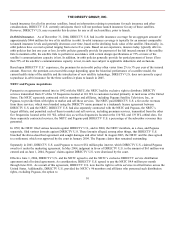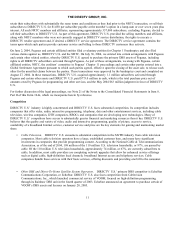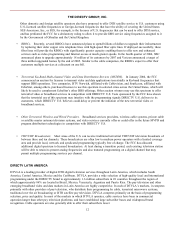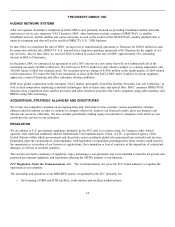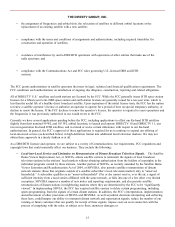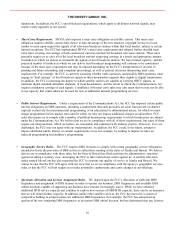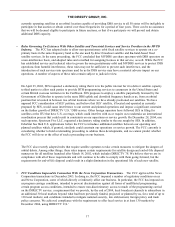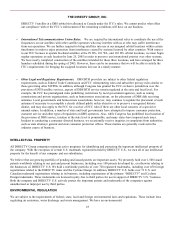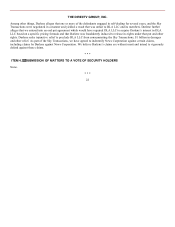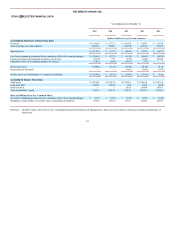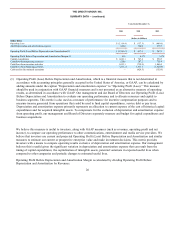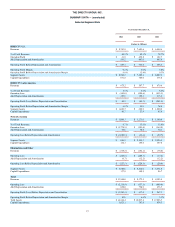DIRECTV 2004 Annual Report Download - page 26
Download and view the complete annual report
Please find page 26 of the 2004 DIRECTV annual report below. You can navigate through the pages in the report by either clicking on the pages listed below, or by using the keyword search tool below to find specific information within the annual report.
THE DIRECTV GROUP, INC.
currently operating satellites at an orbital location capable of providing DBS service to all 50 states will be ineligible to
participate in that auction or obtain control over those frequencies for a period of four years. There can be no assurance
that we will be deemed eligible to participate in future auctions, or that if we participate we will prevail and obtain
additional DBS capacity.
•
Rules Governing Co-Existence With Other Satellite and Terrestrial Services and Service Providers in the MVPD
Industry. The FCC has adopted rules to allow non-geostationary orbit fixed satellite services to operate on a co-
primary basis in the same frequency band as the one used by direct broadcast satellite and Ku-band-based fixed
satellite services. In the same proceeding, the FCC concluded that MVDDS can share spectrum with DBS operators on
a non-interference basis, and adopted rules and a method for assigning licenses in that service, as well. While the FCC
has established service and technical rules to govern the non-geostationary orbit and MVDDS services to protect DBS
operations from harmful interference, these rules may not be sufficient to prevent such interference, and the
introduction of such services into spectrum used by us for DBS service may have a material adverse impact on our
operations. A number of aspects of these rules remain subject to judicial review.
On April 25, 2002, SES requested a declaratory ruling that it is in the public interest for it to deliver satellite capacity
to third parties to allow such parties to provide DTH programming services to consumers in the United States and
certain British overseas territories in the Caribbean. SES proposes to employ a satellite purportedly licensed by the
Government of Gibraltar to operate in the same DBS uplink and downlink frequency bands as us, from an orbital
position that is located in between two orbital locations where we have already positioned our satellites. We have
opposed FCC consideration of SES’ petition, and believe that SES’ satellite, if located and operated as currently
proposed by SES, would cause interference to our current and planned operations and impose a significant constraint
on the further growth of DIRECTV U.S.’ DBS service. Other foreign operators have followed SES in filing for
satellites at the ITU that have U.S. coverage, which could interfere with us or require us to undertake an international
coordination process that could result in constraints on our operations or service growth. On December 28, 2004, one
such operator, Spectrum Five LLC, requested a declaratory ruling similar to the one sought by SES. In addition,
EchoStar has filed U.S. applications before the FCC to introduce additional satellites between our operating and
planned satellites which, if granted, similarly could constrain our operations or service growth. The FCC currently is
considering whether to hold a rulemaking proceeding to address these developments, and we cannot predict whether
the FCC will do so or the effect of such a proceeding on our business.
The FCC also recently adopted rules that require satellite operators to take certain measures to mitigate the dangers of
orbital debris. Among other things, these rules impose certain requirements for satellite design and end-of-life disposal
maneuvers for all satellites launched after March 18, 2002, which includes DIRECTV 7S. We believe that we are in
compliance with all of these requirements and will continue to be able to comply with them going forward, but the
requirements for end-of-life disposal could result in a slight diminution in the operational life of each new satellite.
•
FCC Conditions Imposed In Connection With the News Corporation Transactions. The FCC approved the News
Corporation transactions in December 2003. In doing so, the FCC imposed a number of regulatory conditions on us
and News Corporation, some of which directly or indirectly affect our business. In particular, the FCC has imposed on
us program carriage conditions, intended to prevent discrimination against all forms of unaffiliated programming;
certain program access conditions, intended to ensure non-discriminatory access to much of the programming carried
on the DIRECTV service; a requirement that we provide, by the end of 2004, local broadcast channels to subscribers in
an additional 30 local markets beyond what had been previously funded, projected or planned by us, for a total of up to
130 local markets; and conditions intended to mitigate national security, law enforcement, foreign policy and trade
policy concerns. We achieved compliance with the requirement to offer local service in at least 130 markets by
December 2004, using DIRECTV U.S.’
17





